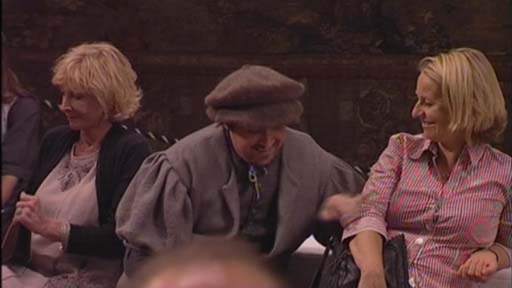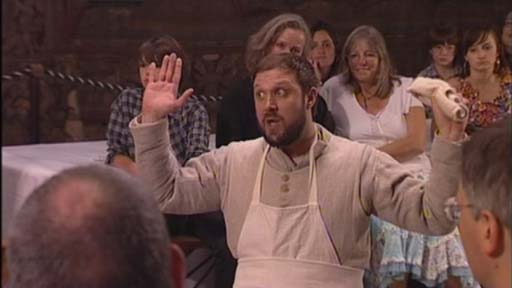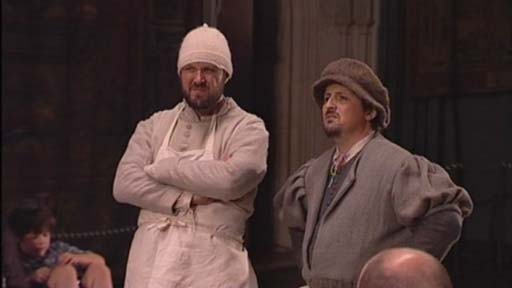The Audience
Dr Eleanor Rycroft

Peter Kenny as The Windmiller
Usually designated as dining halls, Tudor Great Halls could be transformed at seasonal points or for the visits of dignitaries and ambassadors into performance arenas in which spectacular entertainments occurred. The space was mobile in that it allowed performers to both separate from and engage with members of the audience. It was also hierarchical in that the status of the audience would descend from the King's table at the dais end to the more lowly members of the household at the Screen's End, which led to the kitchens beyond.
Early in the process of staging The Play of the Weather, we decided to remove a 'Henry' from the high table at the dais end of the Hall, as we felt that this would radically alter the production without any real hope of recreating the effect of the monarch's presence on the audience or performers. Without having to perform to the king, we were left with traverse staging, rather than a thrust stage along the length of the hall directed towards the royal gaze. This decision was questioned by forum members - with Peter Cockett, for instance, commenting that:
Although interested in the dynamics created by the performance at court, you did not represent the most important person in the room. While it is clearly impossible to recreate the dynamic of the original court, your entire undertaking defies this impossibility and uses performance as a means to imagine the past so it seems odd that you decided not to represent the king on these grounds. Representing the king would have allowed you to explore possible ways the actors might have acknowledged the monarch and how the monarch's reactions might have been part of the spectacle.
However, the decision certainly freed us up to explore the relationship between the audience and performers in the early Tudor interlude.

Ed Woodall as The Watermiller
Internal evidence from interludes suggests the direct address of audience members in this dramatic genre, and a blurring of distinctions between actor and spectator; a dramaturgical feature inherited from the morality play and evident, for instance, in the plays Mankind, Youth and Hick Scorner, among others.
In our production, key moments for audience interaction were blocked in to the performance:
- Audience members were chosen to represent the warring gods by Jupiter in his opening speech.
- Merry Report asked an audience member to hold his torch when he enters the space on the line, "Brother, hold your torch a little higher" (98).
- Merry Report left a moment for audience members to make their own suit to Jupiter after The Boy leaves the stage.
- Throughout the play, the actor playing Merry Report was free to involve audience members when he was directly addressing them. This took the form on various nights of him sitting on audience member's laps, picking out women from the audience as targets for his bawdy jokes, and even, on one night, pickpocketing an audience member's wallet!
The Millers were also selected as prime candidates for exploring interactions between actors and audience. When the Wind-Miller asks the audience to support him in his argument against the Water-Miller, the actor left space for an audience member to suggest reasons for the necessity of wind. Sure enough, one audience member did feel brave enough to suggest 'bellows' during one of our performances; highlighting the potential in early Tudor interludes for spectator ad-libs as an aspect of early Tudor performance conventions. We also spatially explored the breaking down of audience/performer boundaries with the Millers by having an out-of-breath Wind-Miller sit amongst the audience on his entrance.
Our other major intervention in terms of the audience was to segregate them into men and women. We divided the audience on gender grounds for a number of reasons. Tudor audiences would have been composed of factions to some extent, whether grouped together by familial, national, regional or professional allegiance. Dividing the audience into groups bonded by 'likeness' encouraged the audience to view the performance in a different context to other modern theatrical productions. There is also historical support for the audience being divided on gender. For further discussion of this decision watch the video of actor Peter Kenny below.
Actor Peter Kenny on audience reception of The Millers' scene
The audience segregation had a significant effect on the audience - particularly the female half - as Claire Shuttleworth, "the lucky audience member to be nearly sat on by the wind miller!", discussed in the forum:
Dividing up the audience into men and women during the performance was such an unusual experience for a 21st century audience - there are few situations today (in western society at least) where we split up like this, in such a formal way - its effect was to make you very aware of your gendered identity through the performance from looking at -and being looked back at by- the opposite sex the whole way through the performance.
By dividing of the audience into male and female, we were able to approximate some of the formal, patterning elements common to royal spectacle, while simultaneously exploring the somewhat contrary convention in Tudor interludes of equalising the audience and spectator, through such characters as the Millers and Merry Report.












